Great Way To Start An Online Camping Tents Business Selling Camping Tents
Great Way To Start An Online Camping Tents Business Selling Camping Tents
Blog Article
Does Your Backpacking Camping Tent Need a Footprint?
An impact is costly and includes added weight to your knapsack. It additionally isn't particularly durable.
Is camping in a camper really camping?
Eventually, whether or not a camping tent footprint is required depends on where and exactly how typically you're camping. Generally, it's a great idea to utilize one if you camp on abrasive surfaces or in wet conditions.
Tents with Lower Deniers and Waterproof Ratings
Tents with reduced deniers and water-proof rankings have a tendency to be lighter, however they can likewise be a lot more vulnerable. They may need even more regular repair services and have much less interior area than tougher models. If you're a casual backpacker who suches as to take a trip quick and light, this could be great; nevertheless, more experienced hikers recognize that giving up longevity can feature large repercussions down the path.
The denier and water resistant rating of a tent's cover, rainfly, and flooring can assist you identify its livability. Search for higher-denier fabrics on the cover and rainfly, along with taped joints that assist avoid water from seeping through stitches. Some suppliers also utilize warm and sealant throughout building to produce a stronger joint; these are called bonded seams.
The livability of a tent can also be established by its flooring dimensions and ability. A camping tent's floor should be a little smaller than the footprint to stop water from merging under the shelter.
Tents in Rough Surface
Lots of backpacking camping tents include an impact created particularly for their model, which aids make sure an appropriate fit and protects the outdoor tents's base from wetness and sharp objects. Various other makers sell global impacts that can be cut or folded to match an outdoor tents's dimensions.
The type of surface you'll experience is another vital factor to consider for choosing an outdoor tents. For example, if you'll be camping in a canyon or gully, search for a sanctuary that can deal with solid winds. These problems develop disturbance that can make the difference in between enjoying your camping area or suffering pain.
The capability and peak elevation of a camping tent offer you a great idea of its livability, yet extra factors to take into consideration include vestibules (the area of the rainfly covering the doors) and general storage space. For instance, during our wintertime screening of the Marmot Tungsten, its generous 93-by-82-inch flooring easily managed four perspiring backpackers and their puffier shoulder season resting canvas tent bags while still leaving sufficient area for gear and individuals.
Camping Tents in Wet Conditions
Even if your outdoor tents appears completely dry, wetness prowls in the nooks and crannies. With time, it can break down the fabric. That's why it's so crucial to benefit from day of rest to deep-clean your tent and its parts, such as zipper linings, risk loops and flexible webbing straps.
Likewise, make sure to pitch your camping tent in a flat area, not a divot or concave place, to ensure that ground water does not collect in between the tent flooring and impact or tarp. And if you're making use of a footprint, think about a custom-cut one designed for your camping tent's layout. It won't accumulate rainwater the method a common ground cloth or tarp can.
Method setting up and taking down your outdoor tents at home prior to you took off, to get a feel for just how quickly and effectively you can do it. Additionally, practice scouting your outdoor tents in different surfaces to see just how easy it is (or isn't) to do in bad climate condition.
Tents in High-Rise Situations
Camping tents vary in flooring size and livability. For instance, a huge tent with double doors and vestibules like Marmot's Tungsten can handle four backpackers without calling for gymnastics to get in and out or to save equipment.
The minimum path weight requirements is the best spec to contrast versions, as it includes the bare fundamentals: outdoor tents body, rainfly and posts. But bear in mind that the specification excludes tent stakes, individual lines and stuff sacks.
Many backpacking camping tents can stand up to a light summer storm, however some can be swept away by gale-force gusts. Seek a model with strong poles, an increased bathtub-style flooring and joint taping to reduce the possibility of water leaking via. Costlier layouts also have a tendency to feature more powerful products that can stand up to the impact of debris and other pressures.
How long does it take to put up a bell tent?
